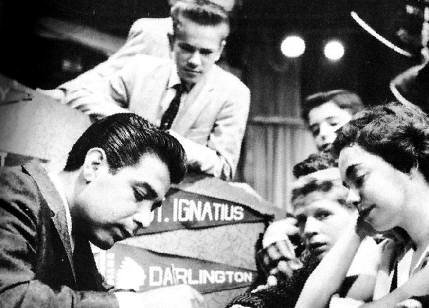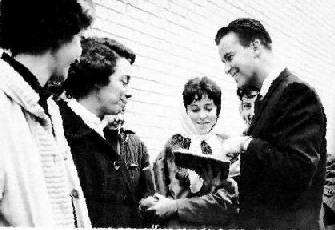Jitterbugging

When the kids on American Bandstand were not Strolling,
or Twisting, or Chalypsoing, they were usually Jitterbugging. The
Jitterbug was a Philadelphia staple, and there were many
variations as there were Philadelphia neighborhoods. The dance
began in the 1920s in the bars of Harlem and took the steps from
the Shag and the Charleston. Although dancers did wild
improvisational solos as part of the Jitterbug, it was
essentially a partner dance. In 1927, the solos gave rise to a
new variation, the Lindy Hop, named after Charles Lindbergh, who
had just made his historic solo flight across the Atlantic. The
Jitterbug gained wide popularity in the thirties when Swing was
at its peak. During WW II, U.S. soldiers took the dance around
the world and it was recognized as quintessentially American
Joyce Shafer, Norman Kerr, Carmen Jimenez, Frank
Vacca

Well Dressed and Well Behaved

Dick Clark's unique talent was taking the music that America was
afraid of - rock 'n' Roll - and broadcasting it while introducing
it to adults that hated it. Well dressed and well behaved, Clark
and kids on American Bandstand were instrumental in
populaizing a new kind of music that was under attack by everyone
from Frank Sinatra, ' the most brutal, ugly, desperate, vicious
form of expression, it has been my misfortune to hear; to Sammy
Davis Jr. "If rock 'n' roll is here to stay, I might commit
suicide; to author Vance Packard, Rock music might be best summed
up up as a montony tinged with hysteria;" to Congressman Tip
O'Neil who said in 1960, "rock and roll is the type of
senuous music unfit for impressionable minds."
Hazards

One of the hazards of dancing on American Bandstand was
the miles of thick black cable that wove itself around the dance
floor for the huge TV cameras that dominated the dance floor. A
white line separated the cameras from the dancers, but the line
was constantly violated as the camera searched for better
pictures of the dancing kids. Often teens had to stop dancing to
step over the cable, an awkwardness rarely seen by the viewers at
home.
Brenda
Lee Day

October 27, 1959, was Brenda Lee Day on American Bandstand.
The 4' 11' dynamo had been performing since she was a toddler, by
the age of six had her own fifteen minute television show. By
twelve, she had several regional country hit songs, including
"Dynamite"(1957) the song that her her nickname
"Little Miss Dynamite". In 1958 she recorded on of the
best rock 'n' roll Christmas songs ever, "Rockin' Around the
Christmas Tree", which wasn't released until 1960, when it
went to the top of the charts. "I'm Sorry", "Sweet
Nothin's" and "I Want To Be Wanted" were in the
Top Ten the next year. In 1962, when she was eighteen, she made
"Break It To Me Gently", a ballad whose emotional
message would have been difficult for a singer twice her age.
Jerry Vale At The Autograph Table

Jerry Vale signing autographs for fans
Sorting
Their Mail

(L to R) Unidentified, Justine Carrelli, Rosemary Fergione,
Arlene Sullivan
Interviewing Ronnie Burns

Ronnie Burns (son of George and Gracie) spends a little time in
the bleachers
Ivette
Jimenez, Myrna Horowitz, and Friends
s
Outside the studio with Dick Clark









